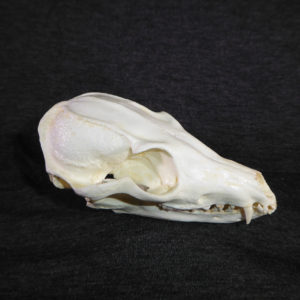Delalandes Fox Skull Replica measures 4.4 inches. Delalandes Fox Skull Replica is museum quality polyurethane cast. Made in the USA. 2-part skull (separate cranium and jaw). Known as Bat Eared Fox.
Delalandes Fox is a species of fox found on the African savanna, named for its large ears, which are used for thermoregulation. Although not commonly used, other vernacular names include Long-eared fox, and Motlosi.
Delalandes Fox are relatively small canids, ranging in weight from 3 kg to 5.3 kg. Head and body length is 46–66 cm, tail length is 23–34 cm, shoulder height is 30–40 cm, and the notably large ears are 11–13 cm longare relatively small canids, ranging in weight from 3 kg to 5.3 kg.
The Head and body length is 46–66 cm, tail length is 23–34 cm, shoulder height is 30–40 cm, and the notably large ears are 11–13 cm long.
Fossil records show this canid first appeared during the middle Pleistocene, about 800,000 years ago.
They are considered a basal canid species, resembling ancestral forms of the family, It has also been called a Sub-Saharan African version of a Fennec Fox due to their huge ears.
Visual displays are very important in communication among bat-eared foxes. When they are looking intently at something, the head is held high, eyes are open, ears are erect and facing forward, and the mouth is closed.
Delalandes Fox has tawny fur with black ears, legs, and parts of the pointed face. It averages 22 in. in length (head and body), with ears 5.1 in. long.
The Delalandes Fox is predominantly an insectivore that uses its large ears to locate its prey. About 80 to 90 percent of their diet is harvester termites.
When this particular species of termite is not available, they feed on other species of termites and have also been observed consuming.
Other arthropods such as ants, beetles, crickets, grasshoppers, millipedes, moths, scorpions, spiders, birds, small mammals, reptiles, and fungi are consumed as well. The insects they eat fulfill the majority of their water intake needs.
The teeth of are much smaller and reduced in shearing surface formation than teeth of other canid species. This is an adaptation to its insectivorous diet. Delalandes Fox is an old species that was widely distributed in the Pleistocene era.
The teeth are not the Delalandes Foxes only morphological adaptation for its diet. On the lower jaw, a step-like protrusion, called the subangular process, anchors the large digastric muscle to allow for rapid chewing. The digastric muscle is also modified to open and close the jaw five times per second.
Delalandes Fox are highly social animals. They often live in pairs or groups, and home ranges of groups either overlap substantially or very little.
In southern Africa, Delalandes Foxes live in monogamous pairs with kits, while those in eastern Africa may live in pairs, or in stable family groups consisting of a male and up to three closely related females with cubs.
Individuals forage, play, and rest together in a group, which helps in protection against predators. They engage in frequent and extended allogrooming sessions, which serve to strengthen group cohesion, mostly between mature adults.
When an individual is in threat or showing submission, the ears are pulled back and lying against the head and the head is low.


